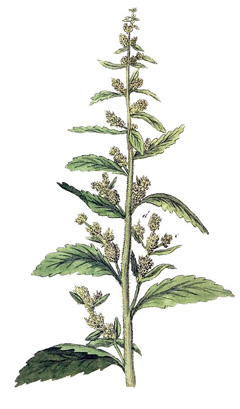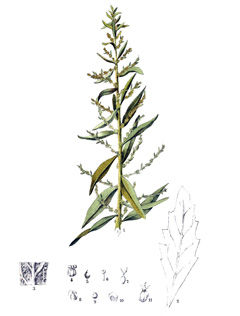 |
|
https://edibleplants.org/ |
 |
| https://edibleplants.org/ |
Translate this page:
Summary
An erect, multi-branched, annual to short-lived perennial plant growing around 1 metre tall. The plant is a popular and very effective vermifuge, as well as having many other medicinalproperties. Prior to the introduction of synthetic compounds the plant was widely cultivated for the control of hookworms and roundworms and it is still often grown for medicinal and culinary use, especially in its native Mexico.
Physical Characteristics

 Dysphania anthelmintica is a ANNUAL/PERENNIAL growing to 1 m (3ft 3in) by 1 m (3ft 3in) at a medium rate.
Dysphania anthelmintica is a ANNUAL/PERENNIAL growing to 1 m (3ft 3in) by 1 m (3ft 3in) at a medium rate.
See above for USDA hardiness. It is hardy to UK zone 10. The flowers are pollinated by Wind.
Suitable for: light (sandy), medium (loamy) and heavy (clay) soils and prefers well-drained soil. Suitable pH: mildly acid, neutral and basic (mildly alkaline) soils. It cannot grow in the shade. It prefers moist soil.
UK Hardiness Map
US Hardiness Map
Synonyms
Ambrina anthelmintica (L.) Spach Atriplex anthelmintica (L.) Crantz Botrys anthelmintica (L.) Nieuwl
Plant Habitats
Edible Uses
Edible Parts: Leaves Seed
Edible Uses: Condiment Drink Tea
Leaves - cooked[ 2 ]. The tender leaves are sometimes used as a potherb[ 183 ]. Used as a condiment in soups etc[ 46 , 61 , 105 ], it is said to reduce flatulence if eaten with beans[ 183 ]. The leaves have a rank taste due to the presence of resinous dots and sticky hairs[ 85 ]. The raw leaves should only be eaten in small quantities, see the notes above on toxicity. Seed - cooked[ 105 , 161 ]. The seed is small and fiddly, it should be soaked in water overnight and thoroughly rinsed before it is used in order to remove any saponins. An infusion of the leaves is a tea substitute[ 183 ].
References More on Edible Uses
Medicinal Uses
Plants For A Future can not take any responsibility for any adverse effects from the use of plants. Always seek advice from a professional before using a plant medicinally.
Analgesic Antiasthmatic Antidiarrhoeal Carminative Dysentery Febrifuge Foot care Parasiticide
Skin Stings Stomachic Vermifuge
Wormseed is a Central American herb that has been used for centuries to expel parasitic worms from the body[ 254 ]. The seed, or the essential oil obtained from the seed and flowering stem is used for this, though all parts of the plant are used medicinally. The plant, especially the essential oil, is toxic in larger doses and so should be used with care and preferably under the direction of a skilled practitioner[ 21 , 238 ]. This remedy should not be prescribed for pregnant women[ 238 ]. See also the notes above on toxicity. Until fairly recently, this was one of the most commonly used vermifuges, though it has now been largely replaced by synthetic drugs[ 222 ]. The seed, or the essential oil, was used[ 213 ]. It is very effective against most parasites, including the amoeba that causes dysentery, but is less effective against tapeworm[ 213 , 238 ]. Fasting should not precede its use and there have occasionally been cases of poisoning caused by this treatment[ 213 ]. The essential oil is used externally to treat athlete's foot and insect bites[ 238 , 240 ]. This is at its highest concentration in the flowering stems before seed is set, these contain around 0.7% essential oil of which almost 50% is the active vermifuge ascaridol[ 240 ]. The essential oil is of similar quality from plants cultivated in warm climates and those in cool climates[ 240 ]. The whole plant is analgesic, antiasthmatic, carminative, febrifuge, stomachic and vermifuge[ 1 , 4 , 21 , 57 , 145 , 147 , 171 ]. An infusion can be used as a digestive remedy, being taken to settle a wide range of problems such colic, diarrhoea and stomach pains; it is also used to treat conditions such as coughs, fevers and internal haemorrhages[ 254 , 348 ]. The leaves are added in small quantities as a flavouring for various cooked bean dishes because their carminative activity can reduce flatulence[ 222 ]. Externally, it has been used as a wash for haemorrhoids, as a poultice to detoxify snake bites and other poisons and is thought to have wound-healing properties[ 254 ]. The macerated leaves and flowers are mixed with a pinch of salt, and used as a poultice for treating persistent sores[ 348 ]. The essential oil is high in ascaridol, a nematicidal terpene peroxide which is active against ascaris, worms and ankylostomes[ 348 ].
References More on Medicinal Uses
The Bookshop: Edible Plant Books
Our Latest books on Perennial Plants For Food Forests and Permaculture Gardens in paperback or digital formats.

Edible Tropical Plants
Food Forest Plants for Hotter Conditions: 250+ Plants For Tropical Food Forests & Permaculture Gardens.
More

Edible Temperate Plants
Plants for Your Food Forest: 500 Plants for Temperate Food Forests & Permaculture Gardens.
More

More Books
PFAF have eight books available in paperback and digital formats. Browse the shop for more information.
Shop Now
Other Uses
Dye Essential Insecticide Parasiticide Repellent
Other Uses: The plant is used as a fumigant against mosquitoes and is also added to fertilizers to inhibit insect larvae[ 238 ]. Gold/green dyes can be obtained from the whole plant[ 168 ].
Special Uses
References More on Other Uses
Cultivation details
A plant of the tropics and subtropics, where it is found at elevations up to 1,500 metres. It grows best in areas where annual daytime temperatures are within the range 15 - 22°c, but can tolerate 4 - 31°c[ 418 ]. It can be killed by temperatures of -1°c or lower[ 418 ]. It prefers a mean annual rainfall in the range 800 - 1,500mm, but tolerates 300 - 4,200mm[ 418 ]. An easily grown plant, succeeding in most soils but disliking shade[ 1 , 200 ]. It prefers a moderately fertile soil[ 200 ]. Prefers a pH in the range 6.5 - 7.5, tolerating 5 - 8.7[ 418 ]. The bruised leaves emit an unpleasant foetid odour[ 245 ]. Flowering Time: Blooms all year
References Carbon Farming Information and Carbon Sequestration Information
Temperature Converter
Type a value in the Celsius field to convert the value to Fahrenheit:
Fahrenheit:
The PFAF Bookshop
Plants For A Future have a number of books available in paperback and digital form. Book titles include Edible Plants, Edible Perennials, Edible Trees,Edible Shrubs, Woodland Gardening, and Temperate Food Forest Plants. Our new book is Food Forest Plants For Hotter Conditions (Tropical and Sub-Tropical).
Shop Now
Plant Propagation
Seed - whilst it can be sown in situ in mid to late spring, we have had better results by sowing the seed in a cold frame in early spring. Put a few seeds in each pot and thin to the best plant if necessary. Germination rates are usually very good and the seedlings should appear within a few days of sowing the seed. Plant out in late spring, after the last expected frosts.
Other Names
If available other names are mentioned here
Chenopodii aetheroleum, chenopodio, chénopode anthelmintique, quenopodio, wormseed goosefoot, wurmtreibender gänsefuß
Native Range
NORTHERN AMERICA: United States (Massachusetts, New Jersey, New York, Pennsylvania, Alabama, Arkansas, Delaware, Florida, Georgia, Louisiana, Maryland, Mississippi, North Carolina, South Carolina, Virginia, Texas), Mexico SOUTHERN AMERICA: West Indies
Weed Potential
Right plant wrong place. We are currently updating this section.
Please note that a plant may be invasive in one area but may not in your area so it's worth checking.
Conservation Status
IUCN Red List of Threatened Plants Status : This taxon has not yet been assessed.

Growth: S = slow M = medium F = fast. Soil: L = light (sandy) M = medium H = heavy (clay). pH: A = acid N = neutral B = basic (alkaline). Shade: F = full shade S = semi-shade N = no shade. Moisture: D = dry M = Moist We = wet Wa = water.
Now available:
Food Forest Plants for Mediterranean Conditions
350+ Perennial Plants For Mediterranean and Drier Food Forests and Permaculture Gardens.
[Paperback and eBook]
This is the third in Plants For A Future's series of plant guides for food forests tailored to
specific climate zones. Following volumes on temperate and tropical ecosystems, this book focuses
on species suited to Mediterranean conditions—regions with hot, dry summers and cool, wet winters,
often facing the added challenge of climate change.
Read More
Expert comment
Author
(L.) Mosyakin & Clemants
Botanical References
Links / References
For a list of references used on this page please go here
A special thanks to Ken Fern for some of the information used on this page.
Readers comment
| Add a comment |
|
If you have important information about this plant that may help other users please add a comment or link below. Only comments or links that are felt to be directly relevant to a plant will be included. If you think a comment/link or information contained on this page is inaccurate or misleading we would welcome your feedback at [email protected]. If you have questions about a plant please use the Forum on this website as we do not have the resources to answer questions ourselves.
* Please note: the comments by website users are not necessarily those held by PFAF and may give misleading or inaccurate information.
To leave a comment please Register or login here All comments need to be approved so will not appear immediately.
|
Subject : Dysphania anthelmintica
|
|
|
|